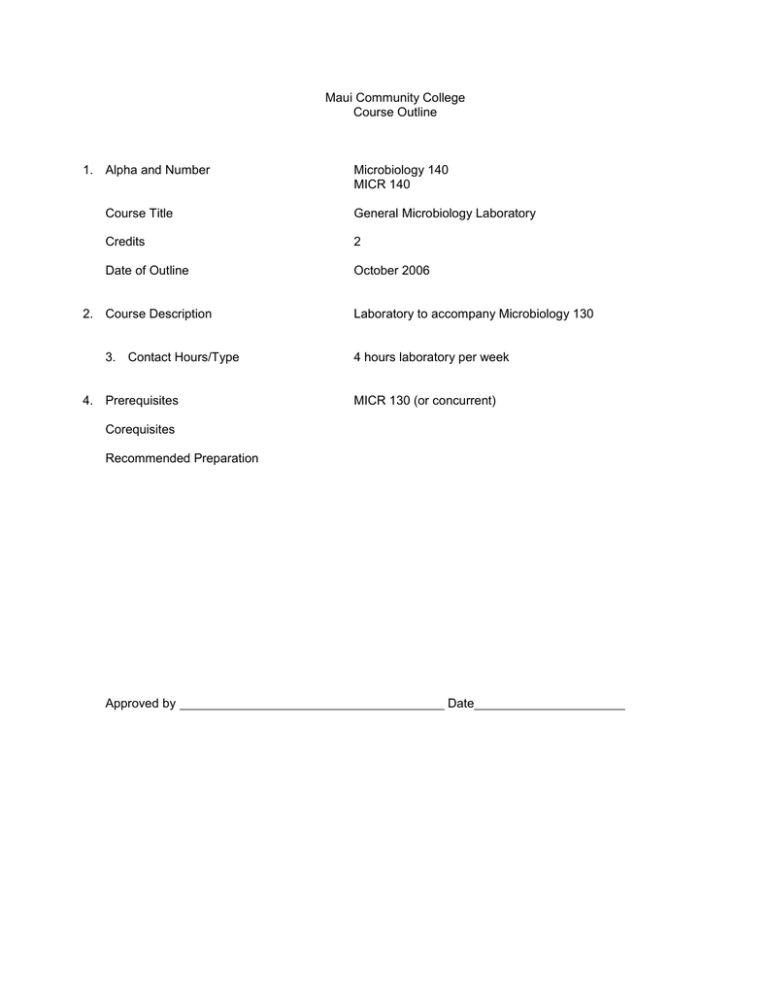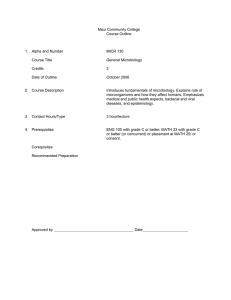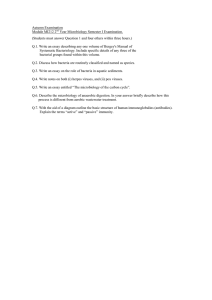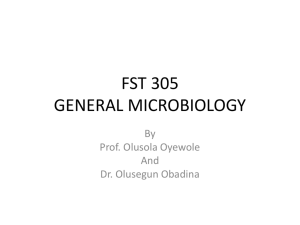F06 Addition
advertisement

Maui Community College Course Outline 1. Alpha and Number Microbiology 140 MICR 140 Course Title General Microbiology Laboratory Credits 2 Date of Outline October 2006 2. Course Description 3. Contact Hours/Type 4. Prerequisites Laboratory to accompany Microbiology 130 4 hours laboratory per week MICR 130 (or concurrent) Corequisites Recommended Preparation Approved by Date 5. General Course Objectives: The student will learn how various microorganisms interact in nature with various other living organisms including humans. This includes a detailed study of the various types of microbes including viruses, bacteria, algae, fungi, and protozoa. The various structures or the organisms, their metabolism, saprophytic and parasitic relationships, genetics, growth, survival, and death are emphasized. Methods of identification, prevention of infection, and control of diseases are included. For detailed information on how Microbiology 140 focuses on the Maui Community College general education standards, see the attached curricular grid. Microbiology 140 fulfills requirements for the AS Degree in Registered Nursing and may be an elective for the Natural Science laboratory requirement for the Maui Community College A.A. and A.S. degrees. Microbiology 140 fulfills the General Education Core Diversification requirements for the University of Hawai’i at Manoa for Natural Science, laboratory science (D/Y.) The General Education Diversification hallmarks achieved by this course include uses the terminology of the biological sciences; involves knowledge and theories relating to processes in the biological sciences; demonstrates inquiry that is guided by observation/experiment; uses the laboratory methods of the biological sciences; involves processes and issues of design, testing, and measurement; and demonstrates the strengths and limitations of the scientific method. 6. Student Learning Outcomes For assessment purposes, these are linked to #7. Recommended Course Content. On successful completion of this course, students will be able to a. explain and demonstrate safe, and emergency, laboratory procedures; b. demonstrate basic microbiological laboratory procedures and protocols including aseptic techniques, culture transfer and maintenance; c. demonstrate proficient use of compound light microscope and dissecting scope; d. differentiate between prokaryotic and eukaryotic organisms; e. differentiate between bacteria, algae, fungi, and protozoa; f. explain the basic biology of prokaryotic organisms, including cell structure, physiology, biochemistry, and genetics; g. demonstrate through laboratory procedures and reports how the basic biology of prokaryotes is used to classify bacteria; h. explain the science behind antibiotic and antiseptic action and resistance in bacteria; i. utilize the scientific method to identify an unknown microorganism; j. critical thinking skills to analyze data relating to issues in microbiology. 7. Recommended Course Content and Approximate Time Spent on Each Topic Linked to #6. Student Learning Outcomes. 1 week: Introduction, laboratory rules and safety (a) 2-3 weeks: Microscopy, cell structure (a,b,c,d,e,f,g) 2-3 weeks: Microbial growth, control of microbial growth, classification of microorganisms (a,b,c,d,e,f,g,j) 2-3 weeks: Microbial metabolism and genetics (a,b,c,d,f,g,j) 1-2 weeks: Applications of genetics and molecular biology to microbiology and medicine (a,b,c,d.g,j) 2-3 weeks: Fungi, algae, protozoa and viruses – focus on medically important phyla (a,b,c,d,j) 2-3 weeks: Antibiotics and antiseptics: where they come from, how they work, new sources (a,b,c,d,e,f,g,h,j) 2 weeks Identification of unknown bacteria (a,b,c,d,e,f,g,h,i,j) 8. Text and Materials, Reference Materials, Auxiliary Materials and Content Appropriate text(s) and materials will be chosen at the time the course is offered from those currently available in the field, such as Johnson and Case. 2006. Laboratory Emperiments in Microbiology, 7th edition. Pearson, Benjamin, Cummings 9. Recommended Course Requirements and Evaluation Specific course requirements are at the discretion of the instructor at the time the course is being offered. Suggested requirements might include, but are not limited to: 10-50% lab practical exams 10-50% lab notebooks 0-20% homework assignments 8-20% lab participation, skills, and safety procedures 8-10% attendance and punctuality 10. Methods of Instruction Instructional methods will vary considerably with instructors. Specific methods will be at the discretion of the instructor teaching the course and might include, but are not limited to a. b. c. d. e. f. g. h. i. j. k. laboratory activities and skills; laboratory reports; data analysis; review worksheets and questions; homework assignments, such as outlining lab procedures; tests and quizzes with discussion and feedback; discussions, videos, CD-ROMs, DVDs, and on-line lessons; library and internet research; projects, service-learning, reports; group work and reviews of current issues and events in microbiology. Assessment of Intended Student Learning Outcomes Standards MiICR MICR BIOL BIOL 130 140 151 151L Outcome 1.1 - Use writing to discover and articulate ideas. 2 2 3 1 Outcome 1.2 - Identify and analyze the audience and purpose for any intended communication. 1 1 2 1 Outcome 1.3 - Choose language, style, and organization appropriate to particular purposes and audiences. 1 1 3 1 Outcome 1.4 - Gather information and document sources appropriately. 2 2 3 2 Outcome 1.5 - Express a main idea as a thesis, hypothesis, or other appropriate statement. 2 2 3 2 Outcome 1.6 - Develop a main idea clearly and concisely with appropriate content. 2 2 3 2 Outcome 1.7 - Demonstrate a mastery of the conventions of writing, including grammar, spelling, and mechanics. 2 2 2 1 Outcome 1.8 - Demonstrate proficiency in revision and editing. 0 1 2 0 Outcome 1.9 - Develop a personal voice in written communication. 0 1 1 0 Outcome 2.1 - Apply numeric, graphic, and symbolic skills and other forms of quantitative reasoning accurately and appropriately. 2 3 2 2 Outcome 2.2 - Demonstrate mastery of mathematical concepts, skills, and applications, using technology when appropriate. 1 2 1 2 Outcome 2.3 - Communicate clearly and concisely the methods and results of quantitative problem solving. 2 2 2 2 Standard 1 - Written Communication Standard 2 - Quantitative Reasoning Outcome 2.4 - Formulate and test hypotheses using numerical experimentation. 1 1 1 2 Outcome 2.5 - Define quantitative issues and problems, gather relevant information, analyze that information, and present results. 1 2 1 2 Outcome 2.6 - Assess the validity of statistical conclusions. 1 1 2 2 Outcome 3.1 - Use print and electronic information technology ethically and responsibly. 2 2 2 1 Outcome 3.2 - Demonstrate knowledge of basic vocabulary, concepts, and operations of information retrieval and technology. 1 1 2 1 Outcome 3.3 - Recognize, identify, and define an information need. 1 1 2 1 Outcome 3.4 - Access and retrieve information through print and electronic media, evaluating the accuracy and authenticity of that information. 1 1 3 2 Outcome 3.5 - Create, manage, organize, and communicate information through electronic media. 1 1 2 2 Outcome 3.6 - Recognize changing technologies and make informed choices about their appropriateness and use. 2 1 3 1 Outcome 4.1 - Identify and analyze the audience and purpose of any intended communication. 1 1 1 0 Outcome 4.2 - Gather, evaluate, select, and organize information for the communication. 1 1 1 0 Outcome 4.3 - Use language, techniques, and strategies appropriate to the audience and occasion. 1 1 1 0 Outcome 4.4 - Speak clearly and confidently, using the voice, volume, tone, and articulation appropriate to the audience and occasion. 1 1 1 0 Standard 3 - Information Retrieval and Technology Standard 4 - Oral Communication Outcome 4.5 - Summarize, analyze, and evaluate oral communications and ask coherent questions as needed. 1 1 1 0 Outcome 4.6 - Use competent oral expression to initiate and sustain discussions. 2 1 2 1 Outcome 5.1 - Identify and state problems, issues, arguments, and questions contained in a body of information. 2 2 2 2 Outcome 5.2 - Identify and analyze assumptions and underlying points of view relating to an issue or problem. 2 2 2 2 Outcome 5.3 - Formulate research questions that require descriptive and explanatory analyses. 2 3 2 2 Outcome 5.4 - Recognize and understand multiple modes of inquiry, including investigative methods based on observation and analysis. 2 2 1 2 Outcome 5.5 - Evaluate a problem, distinguishing between relevant and irrelevant facts, opinions, assumptions, issues, values, and biases through the use of appropriate evidence. 1 2 2 2 Outcome 5.6 - Apply problem-solving techniques and skills, including the rules of logic and logical sequence. 2 3 2 2 Outcome 5.7 - Synthesize information from various sources, drawing appropriate conclusions. 2 2 2 2 Outcome 5.8 - Communicate clearly and concisely the methods and results of logical reasonong. 2 2 2 2 Outcome 5.9 - Reflect upon and evaluate their thought processes, value system, and world views in comparison to those of others. 0 1 1 1 Standard 5 - Critical Thinking




